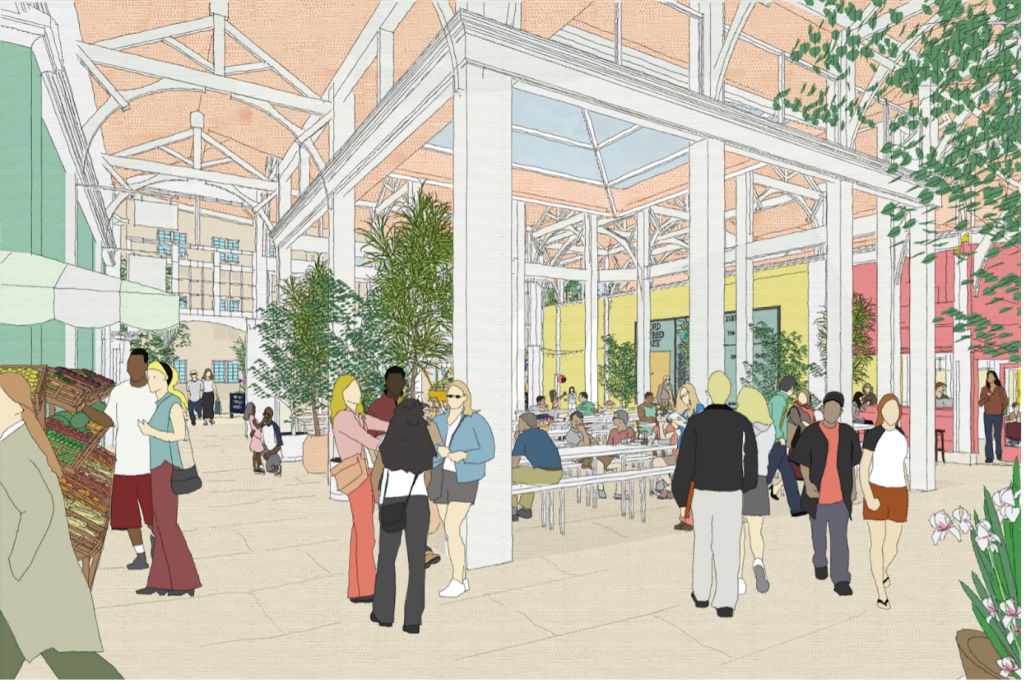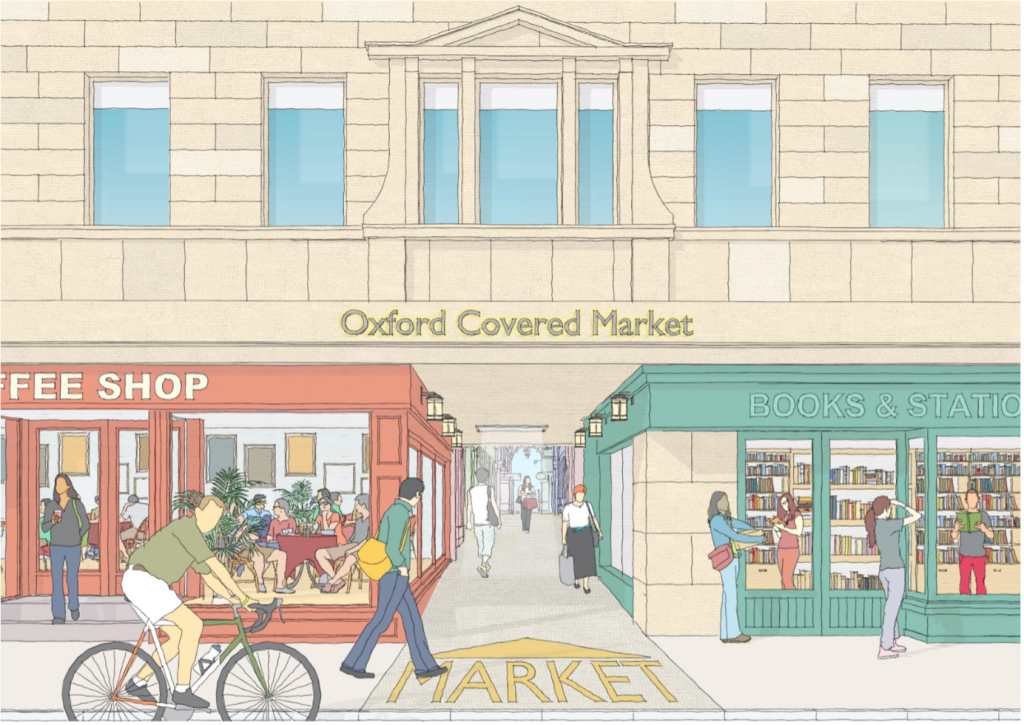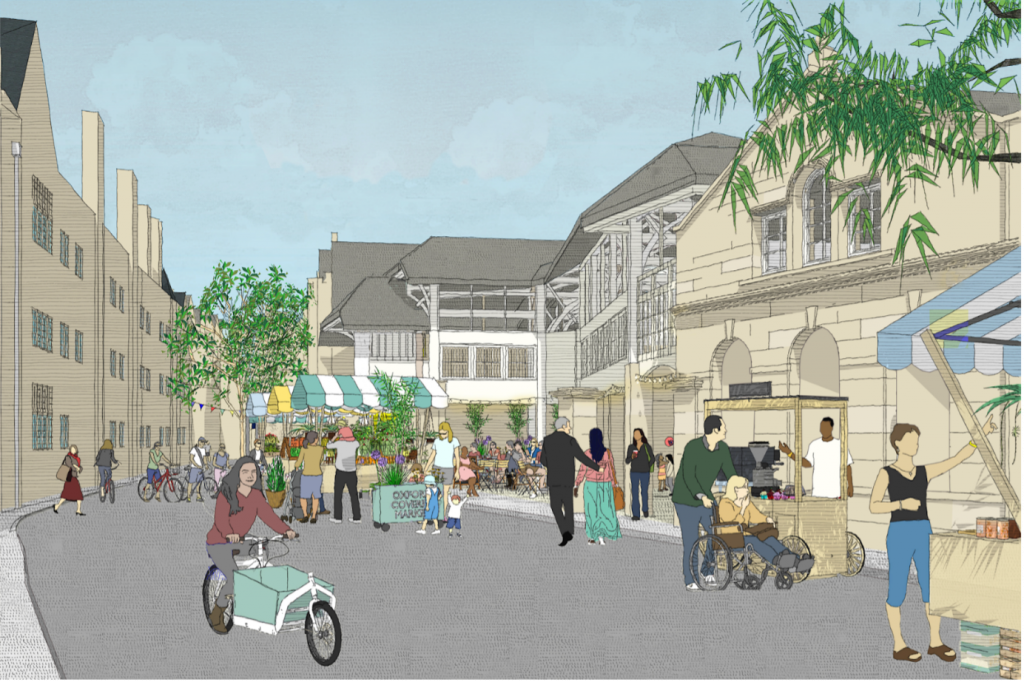Have your say on Oxford’s Covered Market masterplan
Oxford City Council first announced plans to invest in the long term future of the ‘jewel in Oxford’s crown’, the Covered Market, in 2020. An important and much-loved public building, the Council wanted the market’s regeneration to act as a catalyst to make the city centre more inclusive of all its residents.
The Council brought us on board to do community engagement, to talk to citizens of Oxford about their hopes and fears, and what they would like to see in a revamped and restored Covered Market.
If we really wanted a market that was welcoming and inclusive to the whole of Oxford, we needed to start with those who weren’t already visiting the market. We did some initial research, spoke with community leaders around the city, and made a list of people not currently visiting the market, some of whom were not even aware of its existence.
Our research gave us four lines of enquiry, based on the four main characteristics felt to discourage people from visiting the market:
- Age – people felt there was little to do in the market for younger adults, teenagers, and children
- Race – the market is perceived to be a predominantly white space, due to the make-up of traders and existing visitors
- Geography – Most East Oxford communities see Cowley Road, Templars Square, or Blackbird Leys district centre as their town centres and would need a compelling reason to visit the city centre
- Income – the market is perceived as expensive
In early 2021, we spent a month talking to young people, people of colour, people on lower incomes, people who lived on the outskirts of Oxford, and often people who transcended these categories. We spoke with them one-on-one or in small focus groups about the market, the city centre, and how their identities, way of life, and priorities impacted their own personal map of Oxford.
Since then, Oxford City Council and architects Gort Scott have been busy working up some initial proposals for the regeneration, informed by our work and the work of the rest of the design team (including heritage, sustainability, and transport consultants).
Some initial sketches and ideas have now been released and we wanted to share some of our initial findings, so you can see how the proposals relate to what people told us they needed.
What we heard: The city centre can be alienating for those with little money. The city centre has a deficit of places to stop, sit, eat and relax without pressure to spend money – places where you’re not feeling hurried, and you’re not in someone else’s way. These spaces need to be comfortable for everyone, and all access needs. The public toilets at the Covered Market are an essential facility for many people when visiting the city centre.

How do the proposals address this? The proposals include plans for a new public square, situated within the market, near the Market St entrance. The square will open up natural light and ventilation to the space, creating a light and airy space for people to enjoy. Comfortable seating and tables can be used to eat food bought from the market, or simply to sit and enjoy. The free public toilets on Market Street, that are currently open daily between 8am and 5:30pm will be maintained and improved.
What we heard: The market is hidden, its signage unclear and its entrances perceived as dark and foreboding. For those who had experienced feeling unsafe in the city centre, this was off-putting and made them unlikely to enter. The market is out of the way and few routes pass through it, which reduces the chances of visitors discovering it in passing. Once you do find it, the market is chaotic and easy to get lost in, which was off putting for people with access needs.

How do the proposals address this? The entrances onto the High Street are being prioritised, opened up, lightened up, and made more welcoming. The High Street is a key arterial route for everyone in Oxford and easing the threshold between it and the market would help bring new groups of people inside. Signage on the High Street, above the entrances and on the pavement would be improved to make clear what delights can be found inside to anyone travelling along the High Street. Signage and ‘wayfinding’ in the market would be improved to ease navigation, a key cause of anxiety for occasional and first-time visitors.
What we heard: In an online world, the market offered two important physical shopping experiences, daily goods that you want to squeeze and sniff before you buy, and one-off exceptional purchases of a gift or special item. The unique make-up of traders, mostly independent and locally owned, is a much loved and essential part of the market. The market forms part of the ‘experience economy’ of Oxford, and also offers a destination for people who wish to socialise outside of pubs and restaurants. At present, the restricted opening hours of the market contribute to the perception of a lack of activity in Oxford’s night time economy.
How do the proposals address this? The proposals include interventions to support traders, making it easier and more cost-effective for them to function in an environmentally friendly way. Along with the restructuring of the service yard, charging stations for electric vehicles will be installed and Market Street redesigned to better manage deliveries without impacting visitor numbers. In addition, proposals work around new opening hours, including evening opening and the provision of a covered public space for socialising in the evenings. The proposals would include further business support, and initiatives, such as Meanwhile Use (used during the Meanwhile in Oxfordshire programme), could be utilised to bring independent retailers into the market.
What we heard: The climate emergency was front and centre for many of those we spoke to. Participants wanted to know that the redevelopment would make the market fit for a low-carbon 21st Century Oxford, including encouraging more sustainable behaviours from visitors and traders.
How do the proposals address this? Electric vehicle charging points will be installed in the restructured service yard, several sites have been identified for potential new bike parking, and the proposals use the original market structure to encourage natural ventilation. All proposals look to preserve and enhance the existing building.
What we heard: Citizens of Oxford enjoy the prestige that comes with living in this city, but they struggle to insert themselves into this narrative. Participants spoke of the rare publicly-accessible spots in the city where anyone could access the ‘dreaming spires’ and other parts of Oxford’s historic and world-famous architecture. With the publicly-owned market, people wanted the prestige without the exclusion, a public building at home in the iconic skyline of Oxford.

How do the proposals address this? The proposals suggest a monument to ‘publicness’, using sensitive heritage-led architecture to reveal and renew the market’s splendour and to place it at the heart of a bustling and beautiful public realm. Plans include the timed pedestrianisation of Market St and improvements to the public realm to impress the market upon the city and create a more monumental entrance.
What’s next?
Oxford City Council is running a public consultation process from 10 September until 19 October 2022 and Gort Scott will be creating space to explore and discuss the proposals with local stakeholders and gather feedback from the public. We would encourage you to review the plans, and get involved yourself and share the consultation with your friends and family, so
To take part in the consultation, please visit:
https://consultation.oxford.gov.uk/regeneration-economy/covered-market-masterplan-consultation/
There are also in-person consultation events at the Covered Market on the following dates:
- Tuesday 27 September 11am-3pm
- Thursday 29 September 11am-3pm
- Tuesday 11 October 11am-3pm
- Thursday 13 October 11am-3pm
In addition, a Zoom presentation and discussion will take place on:
- Wednesday 12 October 5.30pm – 7pm
For more information, please visit the consultation web page.
